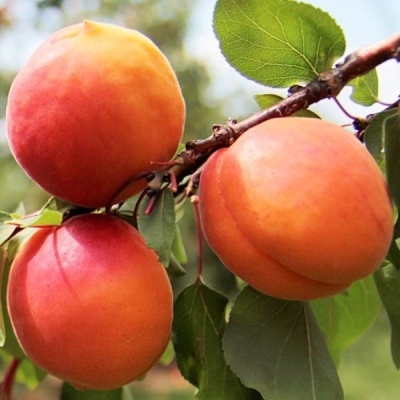
- Authors: Mullayanov K.K., Gasimov F.M.O.
- Name synonyms: Snezhinsky
- Year of approval: 2003
- Tree height, m: 3
- Escapes: straight, brown, naked
- Flowers: medium, white
- Fruit weight, g: 20
- Fruit shape: rounded
- Skin : with slight pubescence
- Fruit color: main - yellow, integumentary - red
Modern varieties of apricots have good frost resistance, they can be grown even in the Urals. At the same time, they give good yields of aromatic, tasty and healthy fruits. All this is inherent in the Apricot Delight. In addition, the variety has strong immunity and is not susceptible to diseases.
Description of the variety
Medium-sized tree. Reaches a height of no more than 3 m. The crown of medium density, rather spreading and raised, reaches 4-4.5 m in diameter. The branches are even and smooth, brown in color. The leaves have an elongated-oval shape with slightly pointed tips, rich green color.
The leaves on the shoots are arranged alternately. Fruit inflorescences of a pale pink tone, large. During the flowering period, the tree exudes a pleasant aroma. The average life span of a tree is 30-40 years.
Fruit characteristics
It has rather large fruits. On average, the mass of one apricot can reach 20 g. Their shape is round and isosceles. The color is rich yellow with a red ruddy side. The skin is soft and loose with slight pubescence, which is difficult to separate from the pulp. In turn, a small bone leaves the pulp easily. The core located inside has a bittersweet taste.
Ripe fruits tend to fall off, so harvest should be done on time. And also do not store the harvested fruits for a long time - the shelf life is short, only a few days.
Taste qualities
The light orange pulp is characterized by a sweet dessert taste with pleasant fruity notes in the aroma. The consistency of the pulp is very juicy and delicate with fine fibers. On a five-point scale, Delight is rated at 4.9 points. The fruits are rich in useful trace elements and substances. It contains a lot of dry matter (11.9%), sugars (4.3%), fruit acids (2.5%), vitamin C (7%).
Ripening and fruiting
Apricot belongs to the early varieties in terms of ripening. In May, the tree begins to bloom, and at the end of June you can already enjoy the ripe fruits. The culture enters fruiting in the 4th year of planting, delighting with the harvest every year.

Yield
The peak of fruit ripening is in July. On average, up to 15 kg of fruit or 57 kg / ha are harvested from one tree. When growing this crop, it should be borne in mind that sudden temperature changes, recurrent spring frosts, high humidity, improper agricultural practices and diseases can significantly reduce the amount of the crop.
Self-fertility and the need for pollinators
The variety is partially self-fertile, so other pollinating trees need to be planted next to the plant to get more fruits. The main thing is to plant a crop with similar flowering times. Such varieties as Manchurian and Kichiginsky have proven themselves well.
Growing and caring
So that the plant does not hurt and gives a good harvest, you need to correctly plant it. Experienced gardeners recommend planting crops in the spring. In the southern regions, it is carried out in early spring, when the threat of return frosts has passed; in the northern regions, the optimal time for planting work is at the end of April or at the beginning of May.
The landing site should be chosen as illuminated as possible. In shaded areas, the apricot grows, but gives a meager harvest, or does not bear fruit at all. Care should be taken to protect young seedlings from drafts.
The culture prefers to grow on neutral or slightly alkaline soils. On acidic soils, apricots practically do not develop or die. Therefore, lime is preliminarily introduced into such land.
Variety Delight has a spreading crown and when planting in the garden, you need to take into account the plant placement schemes. The minimum distance from other crops should be about 4 m. When planted close, trees will compete with each other for water, nutrients and lighting.
Before planting a tree on your site, you need to prepare the site. For this, the soil is carefully dug up. The hole is dug out taking into account the volume of the root system. The approximate dimensions of the hole are 60x60 cm. A drainage layer must be laid on the bottom, then a layer of soil is poured with the addition of peat, compost and sand.
The seedling is placed in the center of the hole, the roots are straightened, covered with the remaining soil mixture, tamped and watered abundantly. For less moisture loss from the soil, a layer of mulch is laid around the trunk.
Follow-up care consists of regular irrigation, fertilization, loosening of the soil and pruning. Young trees are watered no more than 2 times a month, they especially need moisture during flowering and active fruit formation.
They begin to feed the apricot at the 2nd year of planting. In early spring, the soil is enriched with ammonium nitrate, during flowering - with potassium, in the beginning of autumn and winter complex mineral fertilizers are applied.
The earth is loosened after rains and irrigation. Weeds are removed. In spring and autumn, they carry out sanitary pruning of old, dry, damaged branches with signs of diseases. And you should also carry out the formation of the crown, thinning it, giving the desired shape.



































































